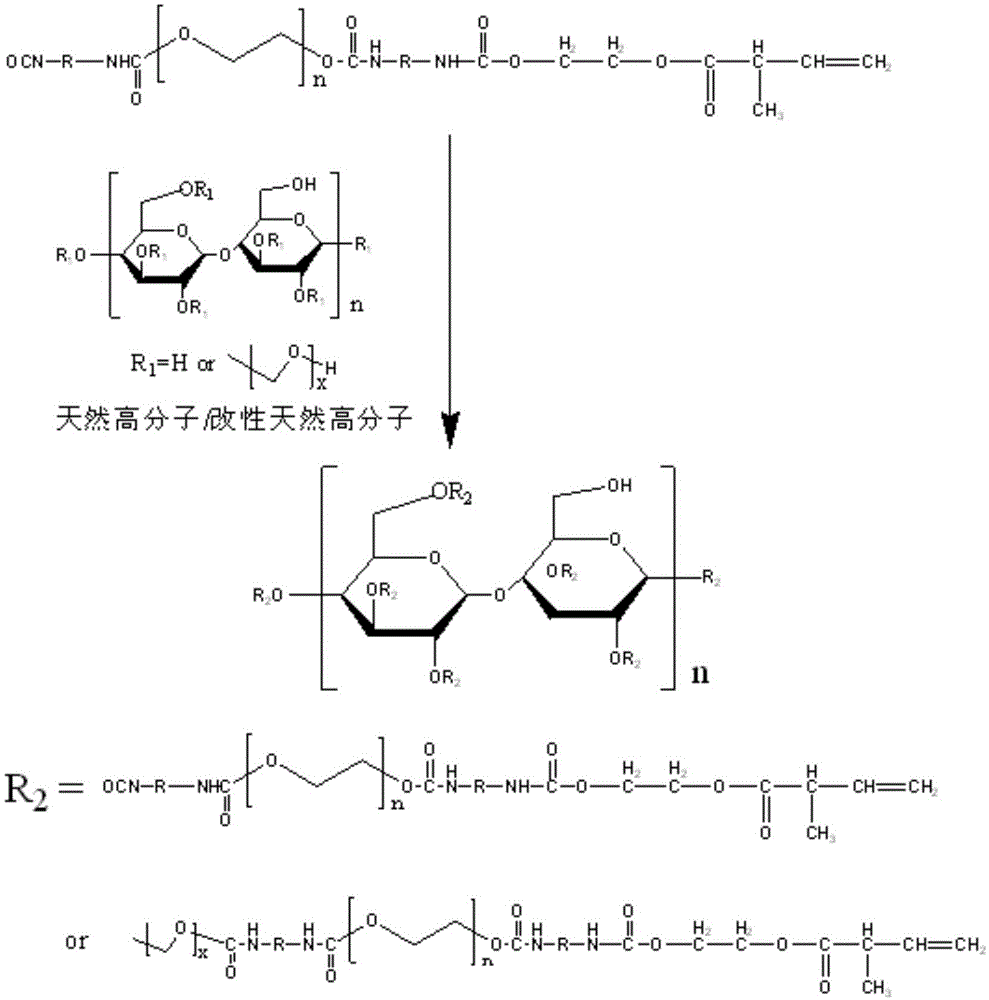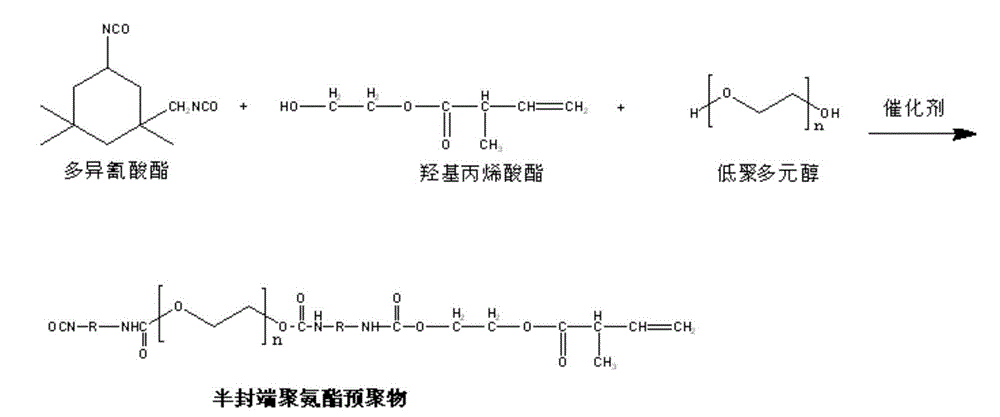A kind of preparation method of natural macromolecule-based photocurable resin
A natural polymer and curing resin technology, applied in the field of light-curing materials, can solve problems such as defects, and achieve the effects of improving comprehensive performance, improving strength and adhesion performance, and improving crack resistance
- Summary
- Abstract
- Description
- Claims
- Application Information
AI Technical Summary
Problems solved by technology
Method used
Image
Examples
Embodiment 1
[0034] A preparation method of natural macromolecular-based photocurable resin, comprising the following steps:
[0035] 1) With butyl acetate as the reaction solvent and dibutyltin dilaurate as the catalyst, fully react isophorone diisocyanate (IPDI) and polyethylene glycol (PEG400), and then add hydroquinone (blocking polymerizer) and hydroxyethyl methacrylate (HEMA) to fully react to obtain a semi-blocked polyurethane prepolymer, the specific operation is as follows:
[0036] Add 0.2mol of isophorone diisocyanate (IPDI) and 15ml of butyl acetate into a 250ml four-necked flask equipped with a stirrer, a thermometer and a condensing reflux tube, add 0.1mol dropwise with a dropping funnel while stirring at room temperature and remove by molecular sieve Polyethylene glycol (PEG400) in water and 0.4229g dibutyltin dilaurate (accounting for 0.5% of the total mass of isophorone diisocyanate and PEG400), react at 80°C for 3h after the dropwise addition; 0.013g of hydroquinone (acc...
Embodiment 2
[0042] A preparation method of natural macromolecular-based photocurable resin, comprising the following steps:
[0043]1) Using ethyl acetate as the reaction solvent and stannous octoate as the catalyst, fully react dimethylene phenyl diisocyanate and polytetrahydrofuran diol 1400, and then add p-methoxyphenol (polymerization inhibitor) and formaldehyde Hydroxypropyl acrylate is fully reacted to obtain a semi-blocked polyurethane prepolymer, and the specific operations are as follows:
[0044] Add 0.2 mol of dimethylene phenyl diisocyanate and 15 ml of ethyl acetate into a 500 ml four-necked flask equipped with a stirrer, a thermometer and a condensing reflux tube, and add 0.1 mol of diisocyanate through a molecular sieve to remove water with a dropping funnel while stirring at room temperature. mol polytetrahydrofuran diol 1400 and 1.2432g stannous octoate (accounting for 0.7% of the total mass of dimethylene phenyl diisocyanate and polytetrahydrofuran diol), react at 40°C f...
Embodiment 3
[0053] A preparation method of natural macromolecular-based photocurable resin, comprising the following steps:
[0054] 1) With propyl acetate as the reaction solvent and dibutyltin dilaurate as the catalyst, fully react isophorone diisocyanate (IPDI) and polyethylene glycol (PEG600), and then add hydroquinone (blocking Polymerizing agent) and hydroxyethyl acrylate are fully reacted to obtain a semi-blocked polyurethane prepolymer, and the specific operations are as follows:
[0055] Add 0.2mol of isophorone diisocyanate (IPDI) and 15ml of propyl acetate into a 250ml four-necked flask equipped with a stirrer, a thermometer and a condensing reflux tube. Polyethylene glycol (PEG600) 0.1mol and 0.6275g dibutyltin dilaurate (accounting for 0.6% of the total mass of isophorone diisocyanate and PEG400.), react at 40°C after the dropwise addition; 0.0413g of hydroquinone (accounting for 0.15% of the mass of hydroxyethyl acrylate) and 0.17mol of hydroxyethyl acrylate (HEMA) were add...
PUM
 Login to View More
Login to View More Abstract
Description
Claims
Application Information
 Login to View More
Login to View More - R&D
- Intellectual Property
- Life Sciences
- Materials
- Tech Scout
- Unparalleled Data Quality
- Higher Quality Content
- 60% Fewer Hallucinations
Browse by: Latest US Patents, China's latest patents, Technical Efficacy Thesaurus, Application Domain, Technology Topic, Popular Technical Reports.
© 2025 PatSnap. All rights reserved.Legal|Privacy policy|Modern Slavery Act Transparency Statement|Sitemap|About US| Contact US: help@patsnap.com


